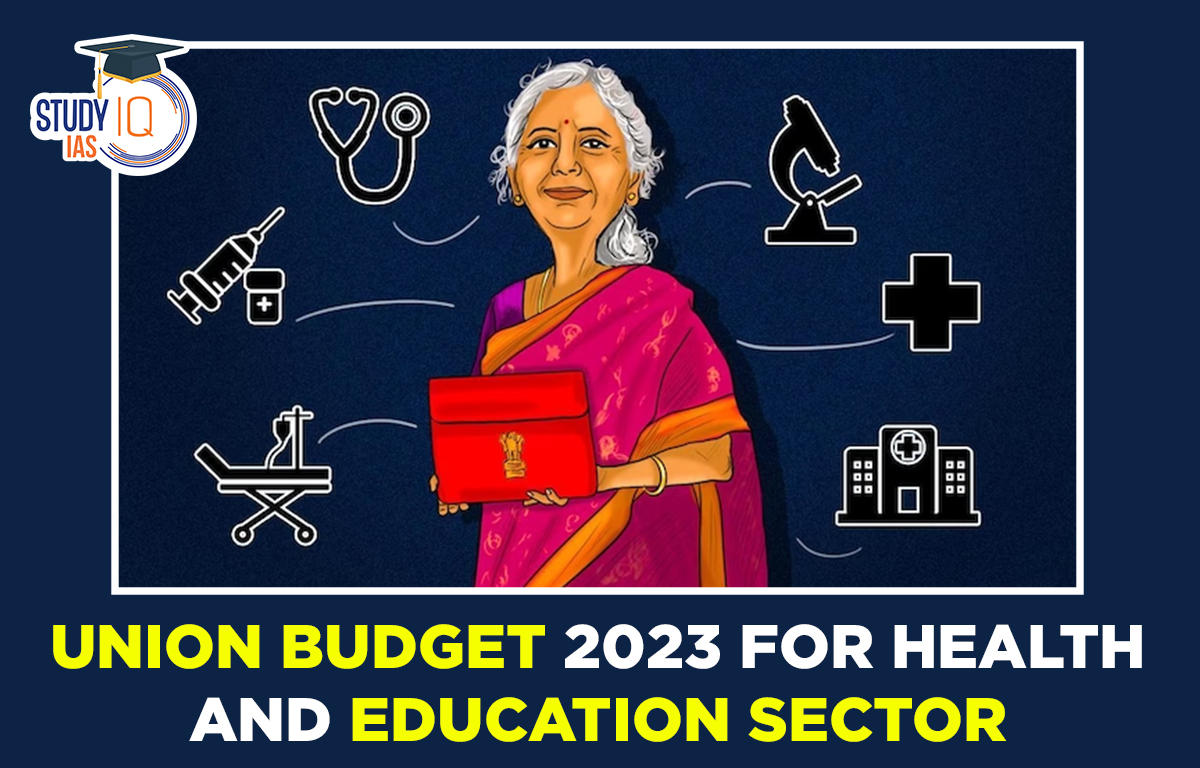Table of Contents
Union Budget 2023 for Health and Education Sector
In Union Budget 2023-24 speech few policies concerning health care, education, and skill development were unveiled on February 1 by Finance Minister Nirmala Sitharaman as part of the priority of “Inclusive Development.” the construction of nursing schools, multidisciplinary medical device courses, a national digital library for children and teens, and a new programme to assist pharmaceutical research and innovation through centres of excellence were examples of actions taken to improve human capital.
A hike in the fund allocation in Union Budget 2023 for Health and Education Sector clearly shows the priorities as well as concerns of the government on providing better health and education for the nation’s development. Compared to the previous year, spending on health and education has increased in absolute terms, but as a percentage of total budgetary allocations, it has slightly decreased.
Read More: Union Budget 2023 for Railways
Union Budget 2023 Highlights for Health Sector
The Ministry of Health’s Budget Estimates for 2022–2023 were initially set at Rs 86,200 crore but were later revised to Rs 79,145 crore at the same time. This year, an estimated 89,155 crore rupees would be spent. In contrast to the previous year, when healthcare spending made up nearly 2.2 per cent of the budget, it fell to 1.97 per cent this year.

- The health sector has been allocated ₹89,155 crores in the Union Budget 2023-24, a hike of around 13 per cents as against ₹79,145 crores allocated in 2022-23, and the Ministry of AYUSH’s overall budget allocation has increased by 20% to Rs 3,647.50 crore.
- Union Budget for 2023-24 states that 157 new nursing colleges will be established in co-location with the existing 157 medical colleges established since 2014.
- By 2047, a mission to end sickle cell anaemia will be launched. Through joint efforts of national ministries and state governments, it will involve raising awareness, universally screening 7 crore persons in the age range of 0-40 years in the impacted tribal areas, and providing counselling.
- The Pradhan Mantri Swasthya Suraksha Yojana (PMSSY) has been split into two sub-schemes as of the start of the 2018 fiscal year. The first is the PMSSY itself, and the second is the establishment costs of 22 new AIIMS, for which Rs 6,835 crore has been set aside. 3,365 crore are set aside in the 2023–2024 budget for the Pradhan Mantri Swasthya Suraksha Yojana.
- The National Health Mission’s budget allocation has increased from 28.974.29 crore in 2022–2023 to 29.085.26 crore in 2023–2024, while the Pradhan Mantri Jan Arogya Yojna (PM-JAY) budget allocation has increased from 6,412 crores to 7,200 crores.

Read More: Union Budget 2023 for Agriculture Sector
Union Budget 2023 Highlights for Education Sector
In the Union Budget for 2023–24, the Center has set aside Rs. 1.13 lakh crore for the education sector, increasing expected spending on K–12 and postsecondary education by about 8.3% from 2022–23 when educational institutions were progressively emerging from the Covid-19 pandemic.
Budgetary allocations for schooling have increased overall by Rs 9,752.07 crore (16.51%), and for higher education, a sum of Rs 44,094.62 crore has been allocated, an increase of 8% from Rs 40,828.35 crore in RE 2022-23. The funding for the Samagra Shiksha scheme, which is anticipated to be the main factor in reversing learning losses, has increased nominally by 0.18 per cent, going from Rs 37,383 crore in 2022–2023 to Rs 37,453 crore in 2023–24.
By increasing the expenditure on PM-Poshan by 13.3%, the allocation went from Rs 10,233 crore in 2022–2023 to Rs 11,600 crore. Sitharaman stated that a National Digital Library will be established for “children and adolescents” to provide a supply of high-quality books at a time when students are attempting to cope with the learning losses caused by the pandemic, despite the fact that no new significant sector-specific schemes were announced.
Read More: Economic Survey 2023
Union Budget 2023 Proposals for Education Sector
- In the next three years, the Centre will recruit 38,800 teachers and support staff for the 740 Eklavya Model Residential Schools that cater to 3.5 lakh tribal students. This year, an estimated Rs5,943 crore would be allocated to these institutions, up from Rs2,000 crore in 2022–2023.
- National Digital Library for Children and Adolescents offers high-quality publications in a variety of languages, genres, and reading levels, as well as cross-platform accessibility. The establishment of physical libraries at the panchayat and ward levels, as well as the provision of infrastructure for the National Digital Library, will be encouraged by the states.
- National Book Trust, Children Book Trust and other sources to provide and replenish non-curricular titles in regional languages and English to these physical libraries to make up for pandemic-induced learning loss.
- The IGOT platform and Mission Karmayogi’s advocacy of online learning will further encourage the adoption of digital technology even in rural and distant areas.
- Pradhan Mantri Kaushal Vikas Yojana 4.0 will be introduced to equip thousands of young people with modern capabilities for Industry 4.0, including coding, AI, robotics, mechatronics, IOT, 3D printing, drones, and soft skills. 30 Skill India International Centers will be established in various States to prepare young people for possibilities abroad.
- A digital epigraphy museum will house the “Bharat Shared Repository of Inscriptions,” which will first digitise one lakh ancient inscriptions.
Union Budget 2023 for Health & Education Sector UPSC
For India’s inclusive and sustainable economic growth and equitable human development, the two defining areas are health and education. Due to the nation’s rapid economic expansion over the past ten years, there are investment gaps in these crucial industries due to the rising demand for public investment in all sectors.
The provision of health and education services to all, particularly the poorest and those living distant from the country’s major growth centres, has increasing challenges in service delivery standards, performance metrics, and technology integration.





















 WhatsApp
WhatsApp